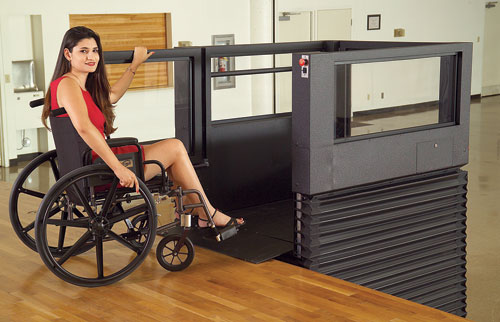Vertical Wheelchair Lifts: Specifying for Safety, Accessibility and Building Needs
No access ramp
Some high-end lifts, both fixed and portable, eliminate the problem of an access ramp altogether by supporting the lift platform in such a way that it is possible to utilize a low-profile platform floor. This minimizes the offset between the lower landing and platform floor, thereby eliminating the need for an access ramp. This solution allows for the truly independent use of a portable lift and gives the building owner installing a fixed lift more flexibility in the installation.
- For portable lifts, it is possible to have a truly independent-use lift.
- When retrofitting an existing facility with a fixed lift, fewer building modifications are required because the lift does not need a pit.
- Decreases maintenance and service needs.
Transition at the upper level
How is the transition managed between the lift floor and the surface of the stage or upper landing sill?
- All fixed lifts have similar interfaces between the lift floor and the upper landing sill.
- More options are available in portable lifts. Some portable models include a hinged automatic dock plate for a smooth transition between the platform and the surface of the stage. This plate makes it easy for a facility's personnel to set the lift in place, since it bridges any gap between the upper landing sill and the lift floor. This plate also enables the lift to be used in front of stages with protrusions (e.g. architectural decorations), uneven surfaces, or stages with a curved fascia. Those lifts without a hinged dock plate are more difficult for facility personnel to set up correctly because they must be positioned with a relatively high level of precision to minimize the gap between the platform floor and the upper landing sill. A large gap is dangerous to users.
 |
Lift showing automatic hinged dock plate for transition at the stage level. Photo: Ascension |
Â
Safety features
While ADA compliant lifts meet basic safety standards, different lift designs can present potential safety issues:
- Are the operating components completely enclosed for the safety of the passenger and public? A typical higher-end model uses durable safety skirting to completely enclose the operating components and the underside of the platform at all times during operation.
- If the underside of the platform is not protected by safety skirting or a solid steel enclosure, does the lift have a safety under pan to stop the downward motion of the platform if an obstruction is encountered as the lift descends? Some lifts omit the safety pan, but this is not permitted by the ASME A18.1 safety code.
- Is the user or the public protected from moving doors and flaps? Is there a railing inside the lift to hold onto? Exposed components and many moving parts increase the number of "pinch points," thus raising the possibility of the user and others getting extremities caught.
Dimensions of the lift sides and lift doors
- Noting that not all lift users will be in a wheelchair, are all four sides high enough for standing occupants to feel safe?
- Some lift designs do not have a lift door on the lower landing end. Instead they design the access ramp to tilt up and serve as a very low front to the lift. Not only could this make some standing users feel unsafe, it is not allowed by the ASME A18.1 safety code for platform lifts unless accompanied by an automatic barrier arm at a height of 35 inches.
- A minimum side height of 42 inches makes the lift safe for people on crutches or walkers. This height still allows the wheelchair user to see above the sides.Â
- Some portable lifts have no lift door on the upper landing end. This could lead to a shearing and crushing hazard when the lift is used at an open stage (such as a portable stage) or at a stage with an overhanging lip. Any part of the body that protrudes past the back edge of the platform floor could get caught under the overhang as the lift platform moves upward. This hazard is eliminated on a portable lift that includes a stage-side lift door that stands at least 6 inches higher than the stage level when the lift platform is at ground level. Such a door also prevents a wheelchair user on the stage from rolling off the stage and into the lift, and prevents the lift from being set up in such a way that it catches and lifts a flexible stage on its way up (because the lift will not fit under the stage). One higher-end portable lift is available with a door extender to ensure that the door is tall enough for any stage height.
- Some lifts are provided without solid side walls. The ASME A18.1 safety code requires solid sidewalls to prevent shearing and crushing hazards.









